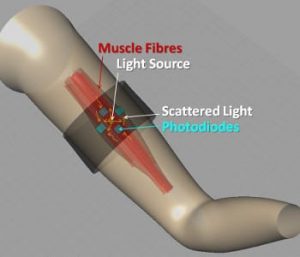 Researchers at the University of St Andrews have developed a light-based sensor that can be used to control the movement of artificial limbs, according to research published today in the journal Advanced Materials.
Researchers at the University of St Andrews have developed a light-based sensor that can be used to control the movement of artificial limbs, according to research published today in the journal Advanced Materials.
Professor Ifor Samuel and Dr Ashu Bansal, of the School of Physics and Astronomy, have developed a new class of wearable optical sensors with potential applications for medicine, rehabilitation and sports.
The team, funded by the Engineering and Physical Sciences Research Council (EPSRC) and the Medical Research Council (MRC), used plastic semiconductors to produce a wearable sensor of muscle contraction. The technology works by shining light into fibrous muscle and observing how the light is scattered. When muscle is contracted the light is scattered less because the muscle fibres are further apart. Sensors are then able to detect the changed scattering signals and relay the information, as photocurrents, to a robotic arm where the action is realised.
The discovery could begin a new era of low cost disposable wearable optical sensors, relieving patients from risks associated with electrical-based sensors including: electromagnetic interference, pain caused by sensing-needles, and immune responses.
Professor Ifor Samuel said:
“Wearable sensors are important for continuous monitoring of health and our approach offers the advantages of being non-invasive, lightweight, flexible and simple to make.
“By using light we avoid needles that would be needed to make electrical contact. A very interesting possible use would be for the control of prosthetic limbs. The muscle movements are detected directly by the optical sensor providing a simple interface to control a prosthetic limb.”
The team demonstrated the application of the muscle contraction sensor by showing that it could be used to control a robotic arm that mimicked the movement of a real arm.
Team member Dr Bansal added:
“This sensor can distinguish different types of contractions and can add extra functionality to active prosthetics enabling natural movements of the limbs, which is not available with currently available techniques.”
The results are important because they suggest how wearable sensors can play a key role in everyday life.
The device consists of a light source and four photodetectors made from semiconducting polymers arranged and assembled as a flexible bandage.
The team anticipated that these findings would be of significant interest across the biophotonics, clinical medicine and plastic electronics community.
Source: University of St. Andrews

















